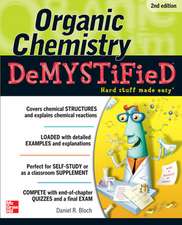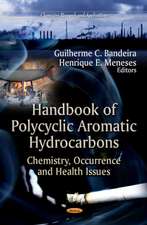Electron Transfer Reactions in Organic Chemistry: Reactivity and Structure: Concepts in Organic Chemistry, cartea 25
Autor Lennart Ebersonen Limba Engleză Paperback – 22 noi 2011
Din seria Reactivity and Structure: Concepts in Organic Chemistry
- 15%
 Preț: 637.93 lei
Preț: 637.93 lei - 15%
 Preț: 638.57 lei
Preț: 638.57 lei -
 Preț: 402.76 lei
Preț: 402.76 lei -
 Preț: 388.13 lei
Preț: 388.13 lei - 15%
 Preț: 650.19 lei
Preț: 650.19 lei -
 Preț: 400.65 lei
Preț: 400.65 lei - 18%
 Preț: 721.63 lei
Preț: 721.63 lei -
 Preț: 378.71 lei
Preț: 378.71 lei -
 Preț: 378.71 lei
Preț: 378.71 lei - 15%
 Preț: 641.53 lei
Preț: 641.53 lei -
 Preț: 380.84 lei
Preț: 380.84 lei - 15%
 Preț: 636.45 lei
Preț: 636.45 lei - 15%
 Preț: 650.37 lei
Preț: 650.37 lei - 15%
 Preț: 640.08 lei
Preț: 640.08 lei -
 Preț: 387.75 lei
Preț: 387.75 lei -
 Preț: 387.20 lei
Preț: 387.20 lei -
 Preț: 380.84 lei
Preț: 380.84 lei - 15%
 Preț: 639.08 lei
Preț: 639.08 lei - 15%
 Preț: 639.08 lei
Preț: 639.08 lei -
 Preț: 381.81 lei
Preț: 381.81 lei -
 Preț: 382.57 lei
Preț: 382.57 lei -
 Preț: 395.25 lei
Preț: 395.25 lei - 15%
 Preț: 642.83 lei
Preț: 642.83 lei - 15%
 Preț: 643.34 lei
Preț: 643.34 lei -
 Preț: 378.54 lei
Preț: 378.54 lei - 15%
 Preț: 636.45 lei
Preț: 636.45 lei - 20%
 Preț: 546.17 lei
Preț: 546.17 lei - 15%
 Preț: 638.43 lei
Preț: 638.43 lei
Preț: 640.06 lei
Preț vechi: 753.01 lei
-15% Nou
Puncte Express: 960
Preț estimativ în valută:
122.48€ • 128.46$ • 101.96£
122.48€ • 128.46$ • 101.96£
Carte tipărită la comandă
Livrare economică 01-15 aprilie
Preluare comenzi: 021 569.72.76
Specificații
ISBN-13: 9783642725463
ISBN-10: 3642725465
Pagini: 252
Ilustrații: XIII, 234 p.
Dimensiuni: 170 x 244 x 13 mm
Greutate: 0.41 kg
Ediția:Softcover reprint of the original 1st ed. 1987
Editura: Springer Berlin, Heidelberg
Colecția Springer
Seria Reactivity and Structure: Concepts in Organic Chemistry
Locul publicării:Berlin, Heidelberg, Germany
ISBN-10: 3642725465
Pagini: 252
Ilustrații: XIII, 234 p.
Dimensiuni: 170 x 244 x 13 mm
Greutate: 0.41 kg
Ediția:Softcover reprint of the original 1st ed. 1987
Editura: Springer Berlin, Heidelberg
Colecția Springer
Seria Reactivity and Structure: Concepts in Organic Chemistry
Locul publicării:Berlin, Heidelberg, Germany
Public țintă
ResearchCuprins
I Electron Transfer, a Neglected Concept in Organic Chemistry.- I.1 Electron Transfer is Fundamental in Many Areas of Organic Chemistry.- I.2 Organic Electron Transfer Theories Come in Cycles.- I.3 References.- II Concepts and Definitions.- II.1 Electron Transfer Can Be Defined in Several Ways.- II.2 Inner-and Outer-sphere Electron Transfer.- II.3 Other Concepts in Electron Transfer Chemistry.- II.4 References.- III Theories of Electron Transfer in Organic Chemistry.- III.1 The Thermodynamic Approach to Electron Transfer Reactivity.- III.2 The Single Electron Shift, a Configuration Mixing Model of Electron Transfer Reactivity.- III.3 The Marcus Theory for Outer-sphere ET.- III. 4 Kinetic Models of Electron Transfer Mechanisms.- III.5 The Marcus Inverted Region.- III.6 The Rehm-Weiler and Agmon-Levine Equations.- III.7 References.- IV How to Use the Marcus Theory.- IV.1 Standard Potential.- IV.2 Reorganization Energy.- IV.3 Case Studies.- IV.4 References.- V Experimental Diagnosis.- V.l Phenomenological Approach.- V.2 Mechanistic Approach.- V.3 Summarizing Remarks.- V.4 References.- VI Reactions Between Organic and Inorganic Non-metallic Species.- V.1 Oxygen Derived Species.- VI.2 Sulfur Derived Species.- VI.3 Nitrogen Derived Species.- VI.4 Halogen Derived Species.- VI.5 Miscellaneous.- VI.6 Summarizing Remarks.- IV.7 References.- VII Reaction Between Organic and Metal Ion Species.- VII.1 One-and Two-electron Reagents.- VII.2 Choice of Metal Reagent and Substrate in Mechanistic Studies.- VII.3 Examples of Established Outer-sphere Mechanisms.- VII.4 Specific Systems.- VII.5 Conclusion.- VII.6 References.- VIII Electron Transfer Reactions Between Organic Species.- VIII. 1 Radical Ions and Radicals as ET Reagents.- VIII.2 Organic Ions and Even-electron Molecules as ET Reagents.- VIII.3 References.- IX Electricity and Light Promoted ET.- IX.1 Organic Electrode Processes.- IX.2 Photochemical ET.- IX. 3 Photoelectrochemistry.- IX.4 Chemiluminescence.- IX.5 References.- X Electron Transfer Catalyzed Reactions.- X.1 Electron Transfer Catalysis as a General Phenomenon.- X.2 An Overview of the ETC Process.- X.3 Different Types of ETC Reactions.- X.4 References.- XI ET and Polar Mechanisms; How Are They Connected?.- XI.1 Formulation of the Problem.- XI. 2 Electrophilic Aromatic Substitution.- XI.3 The SN2 Mechanism.- XI.4 Conclusions.- IX.5 References.- XII Applications of Outer-sphere Electron Transfer.- XII.1 Introduction.- XII.2 Photochemical Fuel Production.- XII.3 Light from Chemical Reactions (Chemiluminescence).- XII.4 Synthetic Applications of ET Reactions.- XII. 5 Conducting Organic Materials.- XII.6 Molecular Electronic Devices of Organic Origin.- XII.7 Oscillating Reactions.- XII.8 Wood Pulping and ET.- XII.9 Toxicity and ET.- XII.10 Degradation Mechanisms of Organic Compounds.- XII.11 References.- Epilogue.









